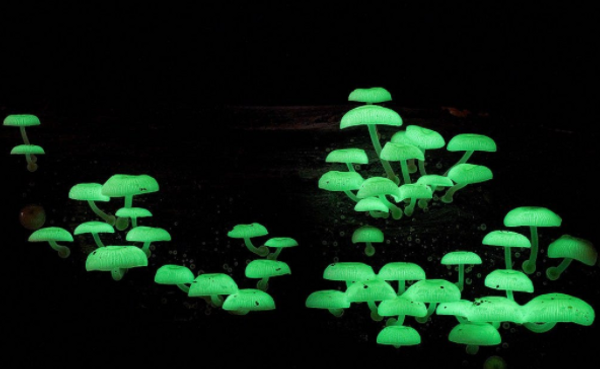Design & Nature Reimagined: Natural light through the night
As spring comes and brings more light later into the day, I've been thinking a lot about how light plays in our life. It's easy for us to flip a switch as night comes, without even thinking about it. However, a lot of material goes into our lighting and the impact of our lights creates light pollution that confuses migrating birds and nocturnal animals and insects.
Because of this, some cities have adopted a Lights Out event during migration season. But what about natural light? Not from the sun but from bioluminescence? Is there a way we could harness that instead, and if we did, would that have fewer harmful effects than our current way of working?
Why lighting confuses and harms wildlife
All animals (including humans) respond to light or darkness in different biological ways. When night comes, different hormones are produced in the bodies of animals who are awake during the day to help us sleep at night. The opposite happens with nocturnal animals. Imagine if the night never came but you were still expected to go to sleep and then continue to function the next day. That's what light pollution does to nocturnal animals; messes up their natural rhythms. This disruption extends to ecosystems as well. Amphibians can be especially sensitive to even dimmer light than humans are aware of. Amphibians are also a bellwether species, and when amphibians suffer we often see other problems in the ecosystem as well.
How bioluminescence works
Bioluminescence, however, is a bio-chemical reaction that allows an animal to light up. There is bioluminescent algae, bacteria, jellyfish, worms, crustaceans, and many more. We don't see bioluminescence in land animals very much, but some of the animals and plants we do see this in are fireflies, glowworms, and mushrooms. Bioluminescence occurs much more frequently in marine animals, especially as we venture deeper into the sea (like I've said before, the ocean is like an alien planet y'all). We see animals use bioluminescent light in all sorts of ways to attack, defend, find food, or mate.
What we learn from bioluminescence
One of the things we can learn from bioluminescent light is how animals use it. They're not using it all the time, but rather at specific intervals. We could replicate this by putting timers on our lights, or dimming our lights so it's not as bright. Additionally, choosing a hooded light that shines down instead of out is one of the best ways to reduce light pollution, and is something you might have more control over with outdoor lights around your home.
But Marisa, I hear you say from the back of the room, can't we use bioluminescence to light up the night? I've honestly been thinking about this for years. Dreaming about it (for real). I love the idea of a naturally generated, soft light that helps us appreciate the darkness in its own way, too. There's a French company called Glowee that's been working on creating a way to make bioluminescence an option for lighting cities. Right now they're using bioluminescent algae that requires quite a bit of feeding and maintenance. I think that this technology is quite far off, except for maybe interactive art pieces. But I think learning more about how the light is produced, and how we might mimic that to reduce our own consumption could help us in the future. As for me, I may try growing some of these bioluminescent mushrooms... maybe I can light the house with those instead?
To get an idea of what my house might look like one day, here's a mushroom that lights up!

